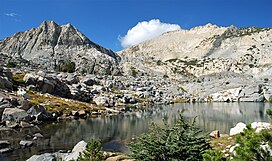Graveyard Peak
 From Wikipedia - Reading time: 6 min
From Wikipedia - Reading time: 6 min
| Graveyard Peak | |
|---|---|
 East aspect (right) | |
| Highest point | |
| Elevation | 11,539 ft (3,517 m)[1] |
| Prominence | 400 ft (122 m)[2] |
| Isolation | 1.59 mi (2.56 km)[3] |
| Coordinates | 37°27′05″N 118°59′24″W / 37.4513100°N 118.9898787°W[1] |
| Geography | |
| Country | United States |
| State | California |
| County | Fresno |
| Protected area | John Muir Wilderness |
| Parent range | Sierra Nevada[2] |
| Topo map | USGS Graveyard Peak |
| Geology | |
| Rock age | Cretaceous |
| Mountain type | Fault block |
| Rock type | Granodiorite, Leucogranite[4] |
| Climbing | |
| First ascent | 1935 |
| Easiest route | class 2[3] |
Graveyard Peak is an 11,539-foot-elevation (3,517 meter) mountain summit located in the Sierra Nevada mountain range in Fresno County of northern California, United States.[1] It is situated in the John Muir Wilderness, on land managed by Sierra National Forest. Graveyard Peak ranks as the 535th-highest summit in California,[3] and topographic relief is significant as the south aspect rises over 2,300 feet (700 meters) above Devils Bathtub in approximately one mile. It is two miles southeast of Silver Peak, five miles north of Lake Thomas A Edison, and approximately 13 miles (21 km) south of the community of Mammoth Lakes. The peak is set on Silver Divide, so precipitation runoff from the north side of this mountain drains into Fish Creek which is a tributary of the San Joaquin River, and from the south slope to Lake Thomas A Edison. The peak is most easily reached out of Lake Thomas Edison.[5]
History
[edit]Graveyard Peak and Graveyard Lakes are named in association with nearby Graveyard Meadows which in turn was named for two sheepmen who were murdered and buried there.[6][7] This landform's toponym has been officially adopted by the U.S. Board on Geographic Names.[1]
The first ascent of the summit was made September 8, 1935, by William Stewart and David Parish.[8]
Climate
[edit]According to the Köppen climate classification system, Graveyard Peak is located in an alpine climate zone.[9] Most weather fronts originate in the Pacific Ocean, and travel east toward the Sierra Nevada mountains. As fronts approach, they are forced upward by the peaks (orographic lift), causing them to drop their moisture in the form of rain or snowfall onto the range.
Gallery
[edit]See also
[edit]References
[edit]- ^ a b c d "Graveyard Peak". Geographic Names Information System. United States Geological Survey, United States Department of the Interior. Retrieved 2022-05-26.
- ^ a b "Graveyard Peak, California". Peakbagger.com. Retrieved 2022-05-26.
- ^ a b c "Graveyard Peak - 11,540' CA". listsofjohn.com. Retrieved 2022-05-26.
- ^ National Geologic Map Database, USGS
- ^ "Graveyard Peak : Climbing, Hiking & Mountaineering : SummitPost". www.summitpost.org. Retrieved 2024-05-10.
- ^ Francis P. Farquhar, Place Names of the High Sierra (1926)
- ^ Peter Browning, Place Names of the Sierra Nevada: From Abbot to Zumwalt, Wilderness Press, 1986, ISBN 9780899970479.
- ^ R. J. Secor, The High Sierra Peaks, Passes, Trails, 2009, Third Edition, Mountaineers Books, ISBN 9781594857386, p. 363
- ^ "Climate of the Sierra Nevada". Encyclopædia Britannica.
External links
[edit]- Weather forecast: Graveyard Peak
- Graveyard Peak (photo): Flickr
 KSF
KSF






